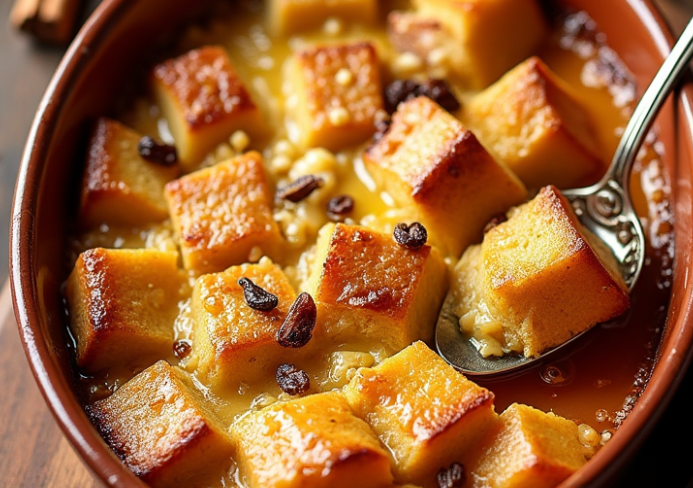How to Make Capirotada: A Mexican Lenten Dish
Capirotada, the traditional Mexican bread pudding, holds a deeply symbolic place in the culture and cuisine of Mexico—especially during Lent. This comforting dish is more than a dessert. It’s a reflection of religious tradition, family history, and culinary creativity. With its signature mix of toasted bolillo bread, piloncillo syrup, cheese, nuts, and dried fruits, capirotada is beloved for both its flavor and meaning.
Table of Contents
This guide will walk you through how to make an authentic capirotada step-by-step, explore its rich history, and offer tips and variations to make it your own.
Introduction to Capirotada
Capirotada is a sweet, layered bread pudding often eaten during Lent, especially on Good Friday. The dish is not only delicious but also rich with religious symbolism. Each ingredient represents an element of the Passion of Christ—bread as His body, syrup as His blood, cloves as the nails, and cinnamon sticks as the wooden cross.
It is traditionally served warm and is most common during Holy Week in Mexican households and communities.
History and Cultural Significance
The origins of capirotada trace back to the colonial era, influenced by Spanish colonizers and Catholic practices. It evolved from savory bread-based casseroles to the sweet dessert we know today. Many families have unique recipes passed down through generations.
For many Catholics, capirotada is more than food—it’s a spiritual expression. The ingredients are not chosen at random. In fact, the dish’s design was historically intended to remind the faithful of Christ’s crucifixion during a time of reflection and penance. To understand more about the meaning behind these ingredients, you can explore this guide on the symbolism of traditional Lenten foods.
Regional Variations in Mexico
Across Mexico, you’ll find countless versions of capirotada—each reflecting local tastes and available ingredients. Some popular regional variations include:
- Northern Mexico: More cheese, often Monterey Jack or even sharp cheddar.
- Southern Mexico: Additions like banana, coconut, prunes, and guava.
- Urban regions: Use of evaporated or condensed milk for a richer pudding texture.
- Tropical styles: Infusions of mango or pineapple for fruity sweetness.
Piloncillo, the unrefined Mexican brown sugar used to make the syrup, is key to all versions. If you’re unfamiliar with this ingredient, check out this excellent overview on piloncillo and its culinary uses.
Traditional Ingredients Used in Capirotada
The beauty of capirotada lies in its flexibility, but here are the traditional ingredients:
- Bolillo or day-old French bread (toasted)
- Piloncillo cones
- Cinnamon sticks
- Whole cloves
- Raisins
- Roasted peanuts
- Shredded cheese (Monterey Jack is most traditional)
- Optional additions: banana slices, coconut flakes, dried fruits
Each family recipe may have a slightly different list, but these are the foundation of most capirotadas.

Essential Equipment Needed
To prepare capirotada, you’ll need:
- A baking dish (preferably 9×9 or similar)
- Medium-sized stockpot (for the syrup)
- Oven for toasting and baking
- Spoons and ladle for layering
- Knife and cutting board
Preparing the Ingredients (Step-by-Step)
Before assembling your capirotada, you’ll want to prepare all ingredients:
- Toast the bread: Slice into thick pieces (~1/3 inch) and toast in the oven at 350°F for 15–20 minutes until golden.
- Make the syrup: In a pot, combine 6 cups water, 3 piloncillo cones, 3 cinnamon sticks, and 3 whole cloves. Heat until piloncillo dissolves and syrup thickens (10–15 mins).
- Prep the add-ins: Chop or soak raisins and other dried fruits. Grate cheese. Measure out peanuts.
Now you’re ready to assemble.
How to Make Classic Capirotada – Step-by-Step
Here’s how to make a traditional version of this Mexican Lenten classic:
- Preheat oven to 350°F.
- Prepare baking dish with light cooking spray or butter.
- Layer 1: Place toasted bread slices on the bottom.
- Sprinkle with raisins, peanuts, and shredded cheese.
- Layer 2: Add more bread, then more add-ins.
- Repeat layers until ingredients are used up.
- Pour syrup evenly over the entire dish until bread is saturated.
- Top with extra cheese or raisins if desired.
- Bake for 35–40 minutes or until golden and bubbly.
- Serve warm, ideally the same day.
Tips for Perfect Capirotada
To ensure the best results:
- Use stale bread so it holds syrup without becoming mushy.
- Pour syrup slowly and evenly to ensure full absorption.
- Let it rest after baking—this enhances flavor and texture.
- Use real piloncillo instead of brown sugar for authentic taste.
- Cover with foil during the first 20 minutes of baking to avoid over-browning.
Creative Variations and Modern Twists
Looking to experiment? Here are some popular ways to personalize your capirotada:
- Vegan: Skip cheese and use coconut milk in the syrup.
- Tropical: Add dried mango, pineapple, or coconut flakes.
- Savory twist: Add queso fresco and reduce sugar.
- Gluten-free: Use gluten-free bread alternatives.
When and How to Serve Capirotada
Capirotada is best served:
- Warm, right out of the oven.
- With a side of atole or café de olla.
- As a dessert during Holy Week, Good Friday, or any Lenten meal.
It can also be enjoyed cold the next day, as the flavors deepen with time.
FAQs about Capirotada
What does capirotada symbolize?
Each ingredient has religious symbolism—bread = body of Christ, syrup = blood, cloves = nails, and cinnamon sticks = the cross.
Can I use regular sugar instead of piloncillo?
Yes, but you’ll lose the deep molasses flavor unique to piloncillo. It’s worth seeking out for authenticity.
Is capirotada eaten hot or cold?
Traditionally hot, but many enjoy it cold the next day.
What kind of bread is best?
Bolillo is preferred, but day-old French bread or baguette also works well.
Can capirotada be made ahead of time?
Yes. Make it the day before and reheat in the oven before serving.
Is capirotada always sweet?
Most versions are, but savory variants exist with less sugar and more cheese.
Final Thoughts
Capirotada is more than a dessert—it’s a celebration of faith, family, and flavor. Whether you’re honoring a Lenten tradition or simply exploring Mexican cuisine, this dish offers a meaningful and delicious experience. Try it once, and it might just become your family’s seasonal favorite.
PrintHow to Make Capirotada: A Mexican Lenten Dish
- Total Time: 1 hour 5 minutes
- Yield: 8 servings 1x
- Diet: Vegetarian
Description
This classic Mexican Lenten dessert layers toasted bolillo, piloncillo syrup, cheese, raisins, and peanuts into a warm, comforting bread pudding that’s both sweet and savory.
Ingredients
- 6 cups water
- 3 piloncillo cones
- 3 cinnamon sticks
- 3 whole cloves
- 4–5 bolillo rolls or French bread, sliced and toasted (~1/3 inch thick)
- 1 cup raisins
- ½ cup roasted peanuts
- 2 cups shredded Monterey Jack cheese
- Optional: banana slices, coconut flakes, or other dried fruits
Instructions
- Preheat oven: Set to 350°F (175°C). Lightly grease a 9×9-inch baking dish with butter or cooking spray.
- Prepare the syrup: In a medium pot, combine water, piloncillo, cinnamon sticks, and cloves. Bring to a boil, then simmer for 10–15 minutes until piloncillo is fully dissolved and the syrup slightly thickens. Strain out the spices and set syrup aside.
- Toast the bread: Lay bread slices on a baking sheet and toast in the oven for 15–20 minutes, flipping once, until golden and crisp.
- Layer the dish: Place a layer of toasted bread in the baking dish. Sprinkle with raisins, peanuts, and shredded cheese. Repeat with another layer of bread and toppings until all ingredients are used.
- Pour the syrup: Slowly ladle the syrup over the entire dish until the bread is well saturated. Top with additional cheese or raisins if desired.
- Bake: Bake uncovered for 35–40 minutes or until bubbly and golden on top.
- Serve: Best served warm on the same day. Optionally pair with whipped cream or vanilla ice cream.
Notes
Every family has its own variation of capirotada. You can experiment with toppings like dried pineapple, banana, or coconut. Always use day-old or toasted bread to absorb the syrup without getting mushy.
- Prep Time: 25 minutes
- Cook Time: 40 minutes
- Category: Dessert
- Method: Baked
- Cuisine: Mexican
Nutrition
- Serving Size: 1 portion
- Calories: 340
- Sugar: 24g
- Sodium: 180mg
- Fat: 14g
- Saturated Fat: 7g
- Unsaturated Fat: 5g
- Trans Fat: 0g
- Carbohydrates: 44g
- Fiber: 2g
- Protein: 9g
- Cholesterol: 25mg
Keywords: capirotada, traditional Mexican dessert, Lenten food, piloncillo bread pudding, cheese and raisin bake






